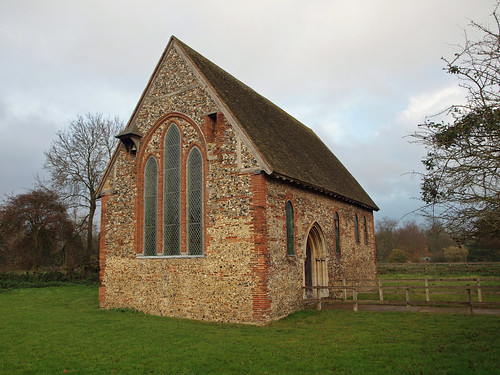ABBEY. The Abbey was founded by King Stephen about 1140 and made Cistercian in 1147. Of the C12 church no traces remain above ground. Of the cloister S of it a little has recently been excavated, C15 buttresses and wall-shafts of the arcades. Of the monastic buildings there are indications of the dormitory, Undercroft (one semicircular C13 respond) and one fine C13 doorway leading into a completely reserved corridor to the E of the former Dormitory. This has single-chamfered ribs and arches to the E. S of it and of the Dormitory a range of unknown purpose. It has lancet windows with round heads inside. The same windows also in a detached building SE of the former. This is not aligned with the Dormitory and cloister. From its style and from documentary evidence Mr J. Gardner attributes these two buildings to c. 1185-90 and the Dormitory to c. 1180. Finally, completely detached from all the rest the chapel of St Nicholas, the gate chapel or capella extra portas of the abbey - a plain rectangle with lancet windows on the N side quite regularly arranged. The date must be about 1225. In this and all the other buildings the most remarkable feature is the extensive use of brick dressings - and brick which is definitely not Roman. It is supposed to be the earliest medieval brickwork in England.
In a delightful pastoral scene on the other side of the Blackwater is a perfect little chapel of the 13th century; we come to it by a brick bridge which has been here 700 years, perhaps the oldest brick bridge in the country. Dedicated to St Nicholas, patron saint of travellers, the chapel stood at the gate of a monastery. It is of interest on its own account and also for the small pink bricks forming the arches of the windows, the piscina, and the sedilia; the bricks are also at the threshold of the doorway where they are cut and shaped into a pattern. These bricks are under two inches thick and are the earliest known in England since Roman days; it is believed that they were made at Tylkell * on the north boundary of the county.
Fading away at the back of the sedilia in this little chapel is a consecration cross marking the place where the bishop put his hand on the wall 700 years ago. It was because the chapel was used as a barn that it escaped the fate of the great church of the abbey at the Dissolution. Not a stone of that church remains to be seen, but its Norman foundations have been traced and found to measure 70 yards long with a width of 80 feet across the transepts.
A group of farm buildings here is of very great interest. One dates from about 1200 and has roof beams 400 years old; and there is a 13th century wing connected by a two-storeyed corridor to a 16th century house built from the ruins of the monastery. The columns and arches we come upon as we wander through this quaint rambling house suggest that the old monks were building for all time.
* Tilkey, adjoining Coggeshall, seems not to be another case, though it lies between Robin's Brook and the Blackwater. Apparently, its name is a corruption of Tylkell, meaning Tile kiln (see Beaumont, Hist. of Coggeshall, p. 113: 1890).
Simon K -
This is not a parish church at all, but the restored capella ad porta of a medieval abbey, set along a rutted lane in the middle of a field of horses. However, for those of us who don't like horses, the path up to it is reassuringly fenced in. It isn't at all as attractive or interesting as the church at Tilty which performed a similar function, being virtually rebuilt in the 19th Century, and in any case was closed.
Flickr.
Fading away at the back of the sedilia in this little chapel is a consecration cross marking the place where the bishop put his hand on the wall 700 years ago. It was because the chapel was used as a barn that it escaped the fate of the great church of the abbey at the Dissolution. Not a stone of that church remains to be seen, but its Norman foundations have been traced and found to measure 70 yards long with a width of 80 feet across the transepts.
A group of farm buildings here is of very great interest. One dates from about 1200 and has roof beams 400 years old; and there is a 13th century wing connected by a two-storeyed corridor to a 16th century house built from the ruins of the monastery. The columns and arches we come upon as we wander through this quaint rambling house suggest that the old monks were building for all time.
* Tilkey, adjoining Coggeshall, seems not to be another case, though it lies between Robin's Brook and the Blackwater. Apparently, its name is a corruption of Tylkell, meaning Tile kiln (see Beaumont, Hist. of Coggeshall, p. 113: 1890).
Simon K -
This is not a parish church at all, but the restored capella ad porta of a medieval abbey, set along a rutted lane in the middle of a field of horses. However, for those of us who don't like horses, the path up to it is reassuringly fenced in. It isn't at all as attractive or interesting as the church at Tilty which performed a similar function, being virtually rebuilt in the 19th Century, and in any case was closed.
Flickr.

No comments:
Post a Comment